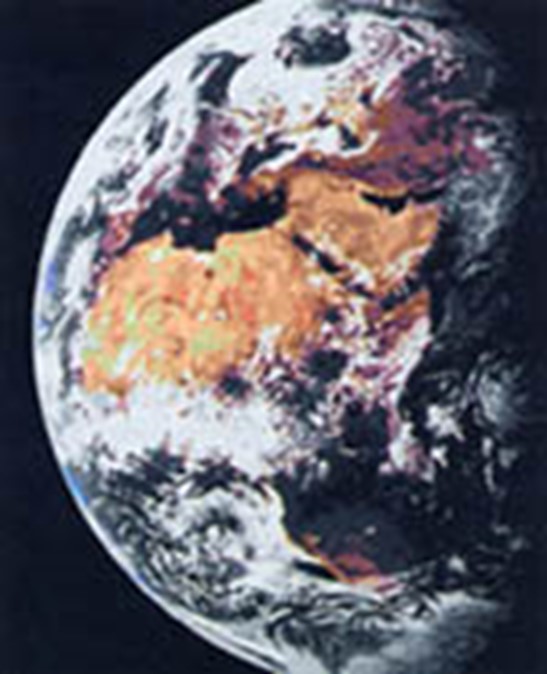
God in Creation Part 2 – LIFE ON EARTH
In 1969, when the astronauts Armstrong and Aldrin were on the stark and desolate landscape of the Moon, they were able to see the Earth as it had never been seen before. Just as we on Earth can look up at the Moon, so they were able to see the Earth rising over the barren lunar surface.
From this distance there is nothing to indicate that the Earth was any different from the lifeless Moon with its craters and plains, or from any other planet of the solar system.
However, those astronauts knew that beneath those reflecting clouds and alongside the shimmering oceans was a different world – one as full of beauty as the other is empty and sterile.
Yes, as far as we know, the planet Earth is unique. It is easy to forget that. There is no actual evidence that there is another place like Earth. What is it that makes Earth so different? Is it the mountains and valleys, its rocks, its minerals? No, other planets have these features. The supreme difference is that the Earth contains life. Wherever we look there are living things of amazing diversity and complexity – trees, plants, animals, birds, fish and insects. Chief among these living things is Man himself, with his unique ability to reason.
 We might well ask, ‘What is the difference between the Earth and the other planets that enables this phenomenon of life to occur? Are such differences accidental?’
We might well ask, ‘What is the difference between the Earth and the other planets that enables this phenomenon of life to occur? Are such differences accidental?’
To answer this question we must note the conditions necessary for life to exist. The Universe as a whole is a dangerous place. Vast spaces, intense and powerful radiation, extremes of temperature from a little above absolute zero (minus 273 degrees Centigrade), to millions of degrees above, combine to make the Universe inhospitable to life. Living things are very delicate and even small variations from certain conditions mean death.
Here are some of the criteria that have to be met for life to exist:
- Temperature range
The range at which living things can function is small on a universal scale. At low temperatures all living processes stop around 0C, when water freezes and the upper limit for growth is around 45C. (Some forms of micro-organisms can grow at higher temperatures and others survive but do not grow in boiling water; even so the temperature range for growth is comparatively small).
- Water
All living processes take place in water. Our body consists of 70% water and many forms of life exist in water. Life cannot exist without water.
- Energy source
Living things stay alive by extracting energy from chemical reactions. In most cases this is done by breaking down food. The energy in food originally comes from the Sun. Plants capture the energy by means of a very special substance called chlorophyll and use the energy to make foodstuff that animals can eat, thus extracting the Sun’s energy second-hand. Light is therefore essential to all the higher forms of life.
- Atmosphere
Most living things require oxygen in order for them to extract the energy contained in food.
- Correct force of gravity and atmospheric pressure
The astronauts on the Moon could jump higher and farther than on Earth because the Moon’s gravitational pull is less. Conversely, on a large planet gravity would crush them into the ground. On Earth, the atmospheric pressure is about 14 pounds per square inch. If it were a lot more than this, living things would be squeezed to death.
- Freedom from radiation
Space is full of rays that are lethal to living things: gamma rays, x-rays, ultraviolet rays and cosmic rays have sufficient energy to break up complex life chemicals. Astronauts have to wear specially designed suits to protect them from this radiation when they venture from their spacecraft.
cosmic rays have sufficient energy to break up complex life chemicals. Astronauts have to wear specially designed suits to protect them from this radiation when they venture from their spacecraft.
- Only Earth suitable for life
Of all the planets, only the Earth has all these things life needs. It is the correct distance from the Sun to give it the right temperature range and has plenty of water in liquid form. If it was only very slightly nearer the Sun, its water would boil off; a little further away and the oceans would freeze. It has an atmosphere containing oxygen and whilst allowing light through, is thick enough to prevent the dangerous rays in space reaching the Earth’s surface. The atmospheric pressure is not excessive and the Earth is of a size that exercises a force of gravity that is compatible with living things.
A review of the features of other planets shows how unsuitable they are to sustain life:
| MERCURY | Moon-like surface – no water – very hot – no atmosphere |
| VENUS | Moon-like surface – extremely hot (5000C) – atmosphere of carbon dioxide and sulphuric acid vapour – atmospheric pressure 100 times that of Earth |
| MARS | Dry rocky surface – no water – ‘ice caps’ are solid carbon dioxide – negligible atmosphere – temperature generally very cold |
| JUPITER | Not a solid planet – consists of liquid hydrogen at a temperature of minus 270o C – bathed in clouds of ammonia hundreds of miles thick |
LIFE IS THE EXCEPTION
Thus it can be seen that certainly in the solar system, possibly in the Universe, the Earth is unique and life is the exception. Why? Advocates of the theory of Evolution believe that because the Earth by chance, had the suitable conditions, life spontaneously developed and then diversified. They say that life was an almost expected result of those fortuitous and accidental conditions.
Others, including the publishers of this booklet, believe that the whole system is part of a plan. In the development of the Universe and the suitability of the Earth they see the guiding hand of a Creator who wanted intelligent life and therefore created first the materials and then the environment to achieve it.
WHAT IS LIFE?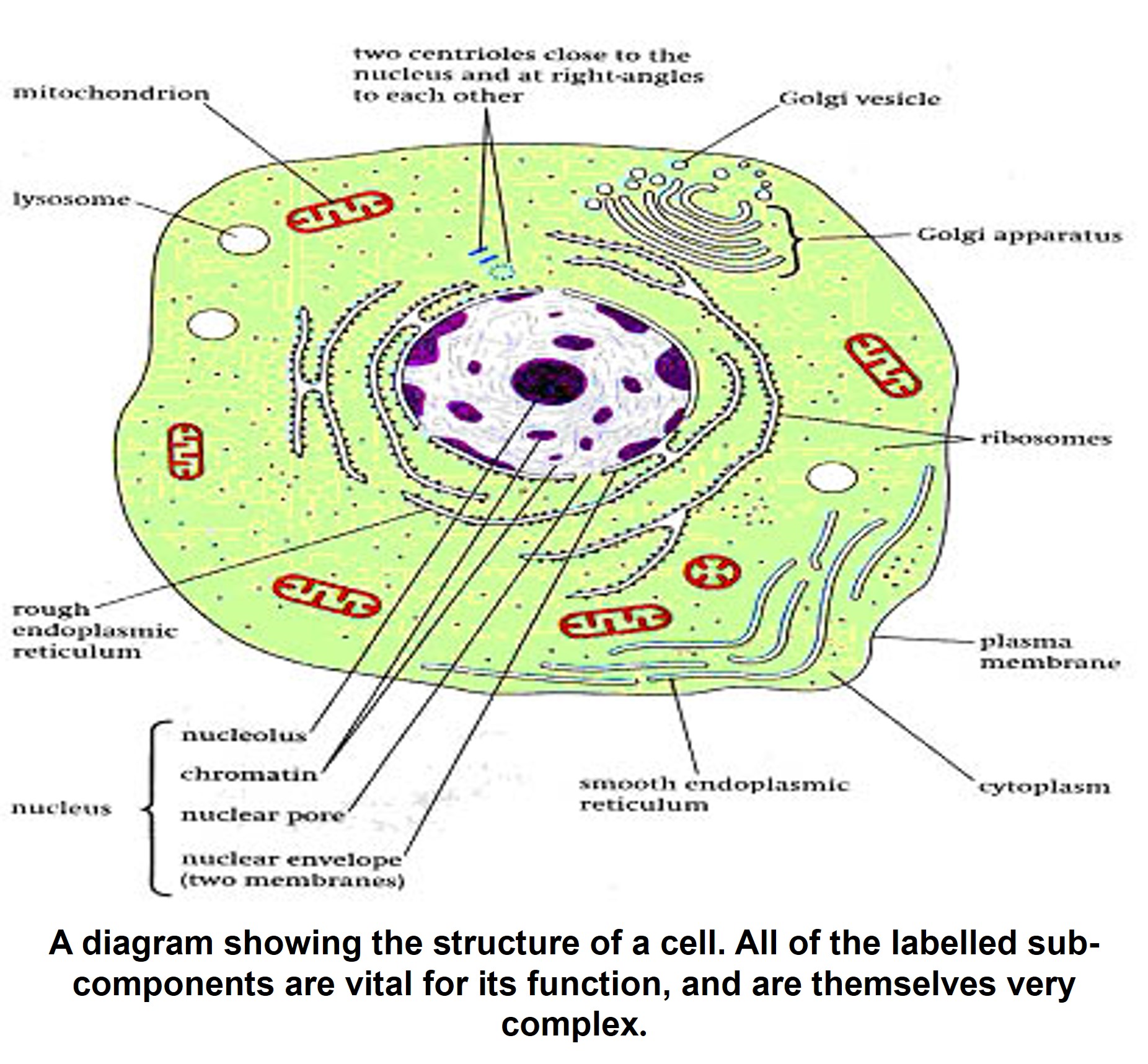
There is no gradual transition from non-living chemicals to living things. Even the simplest form of life contains very specialised chemicals that are never found free in nature. This is because living matter is invariably found inside a microscopic box called a cell. Some forms of life exist as a single cell, but the more familiar ones such as plants and animals are made up of vast numbers of cells joined together. When people rather glibly talk of life spontaneously appearing, they are taking a huge intellectual jump that has very little to justify it. As you read on you will see what we mean.
THE COMPLEXITY OF A LIVING CELL
A living cell is a miniature manufacturing unit, complete with its own power supply. The things it makes are the various complex chemicals needed for it to live, grow and reproduce.
One of the most important series of chemicals are special proteins, called enzymes. In a human manufacturing process a device called a ‘jig’ is often used to hold components in the right place whilst they are being joined together. An enzyme is a microscopic ‘jig’ that holds two or more chemicals together whilst they react and are welded into one – or sometimes they are split in two. Obviously, such a ‘jig’ has to be just the right shape so that it can hold the chemicals in the correct relationship.
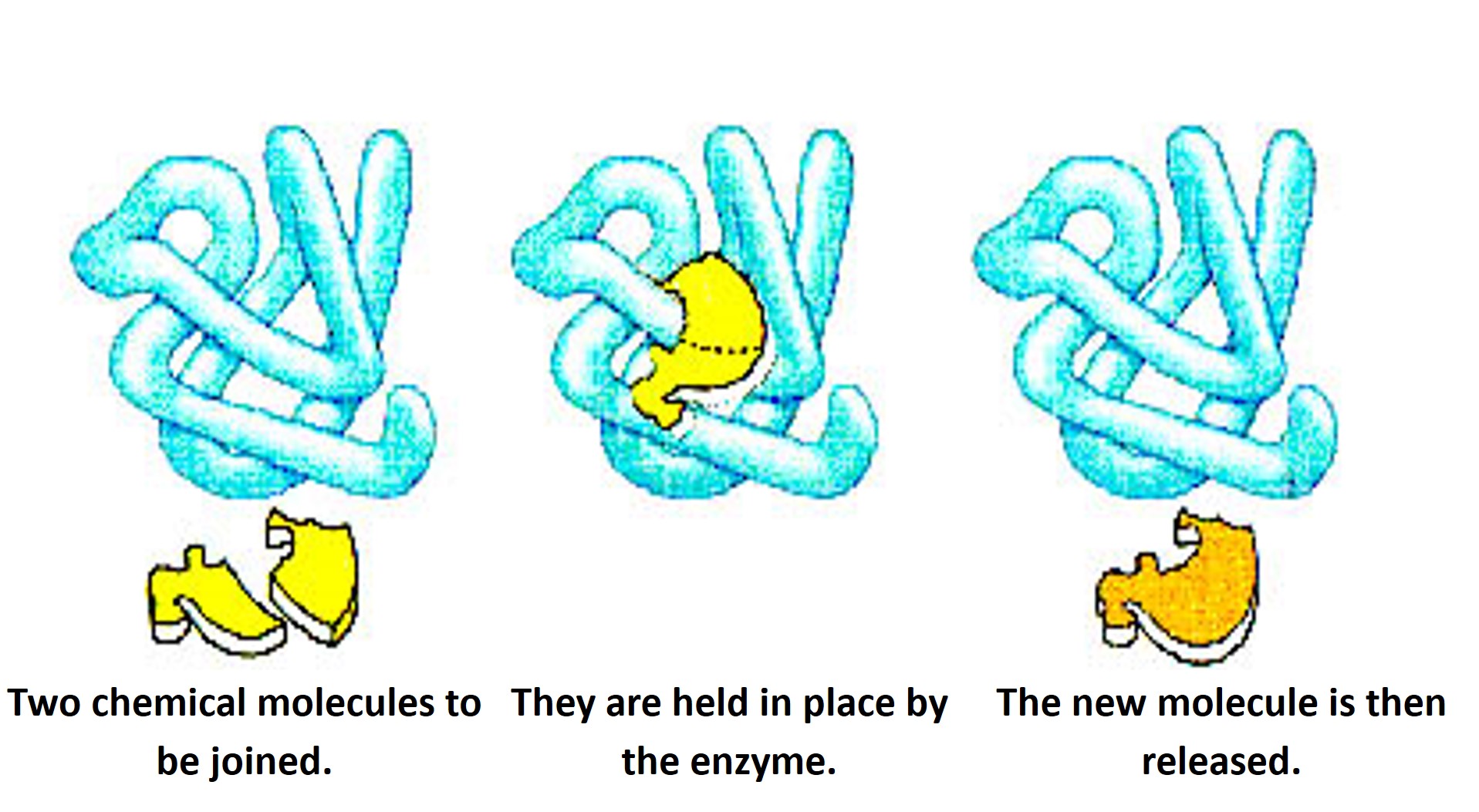
These chemicals are of all shapes and sizes, so this means that there has to be a completely different ‘jig’ or enzyme for each chemical reaction within the cell. Even the simplest cell could not function with fewer than several hundred different enzymes. For example, the simplest known living organisms are called Mycoplasma. One scientist says, ‘these represent almost the smallest size compatible with life.’ He goes on to say that ‘this ‘simple’ cell can produce seven hundred different proteins and that half of this number are considered essential for the life of the cell.’ 3
Reference
3 Professor David Taylor-Robinson: Topley and Wilson’s principles of Bacteriology, Virology and Immunity, 8th edition 1990, Volume 2, page 672.
ENZYME STRUCTURE
Below is a diagram representing an enzyme, its special shape designed to hold its reacting chemicals. You can see that it is a long chain bent and twisted into the necessary shape. How does it get bent in just the right places so that its unique chemicals fit exactly into this ‘jig?’
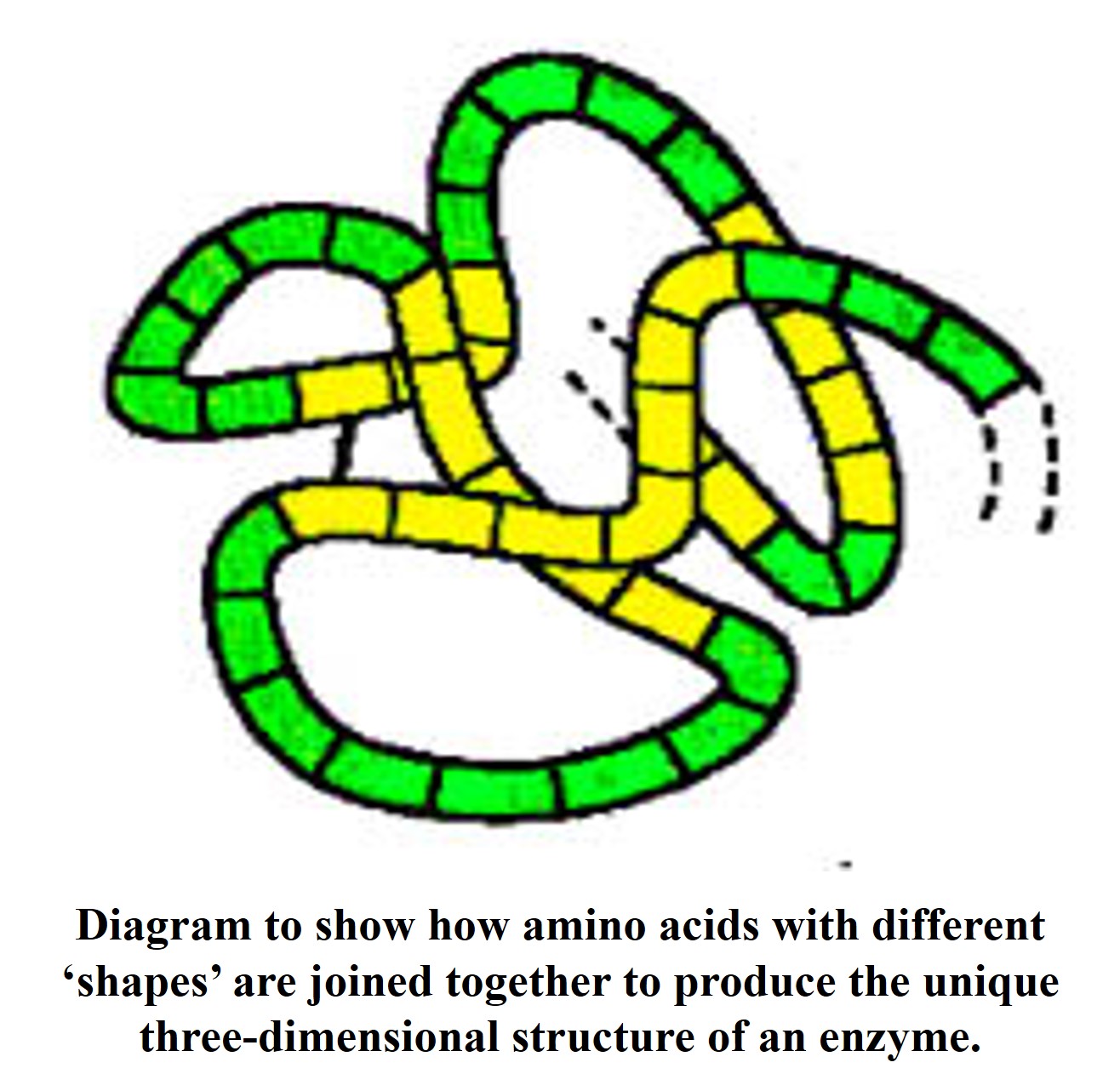
If you placed a row of square bricks end to end they would obviously form a straight line. If you introduced into the row a brick with a triangular cross-section, a bend in the row would be obtained. An enzyme molecule is constructed on this principle, using chemicals called amino acids as its ‘bricks’. There are about 20 different amino acids and in effect, they are all different ‘shapes.’ Also, some amino acids have the property of ‘clipping on’ to others further down the chain, thus creating a loop. By careful selection of the various amino acids (and there are usually many hundreds in the enzyme chain) the molecule can be bent into the requisite three-dimensional shape.
Now the important thing! Obviously, to produce a given enzyme there is only one correct sequence of amino acids. The substitution of just one amino acid in the sequence could produce a ‘bend’ in the wrong place, with the result that the enzyme would be unable to hold its particular chemicals and would thus be useless.
So the cell in some way has to remember the correct sequence of amino acids in every one of the hundreds of different enzymes it needs, so that it can make them when required. If it gets even one amino acid in the wrong place in the line, the enzyme might not work properly. How does the tiny cell ensure this correct sequence?
THE CODE OF LIFE
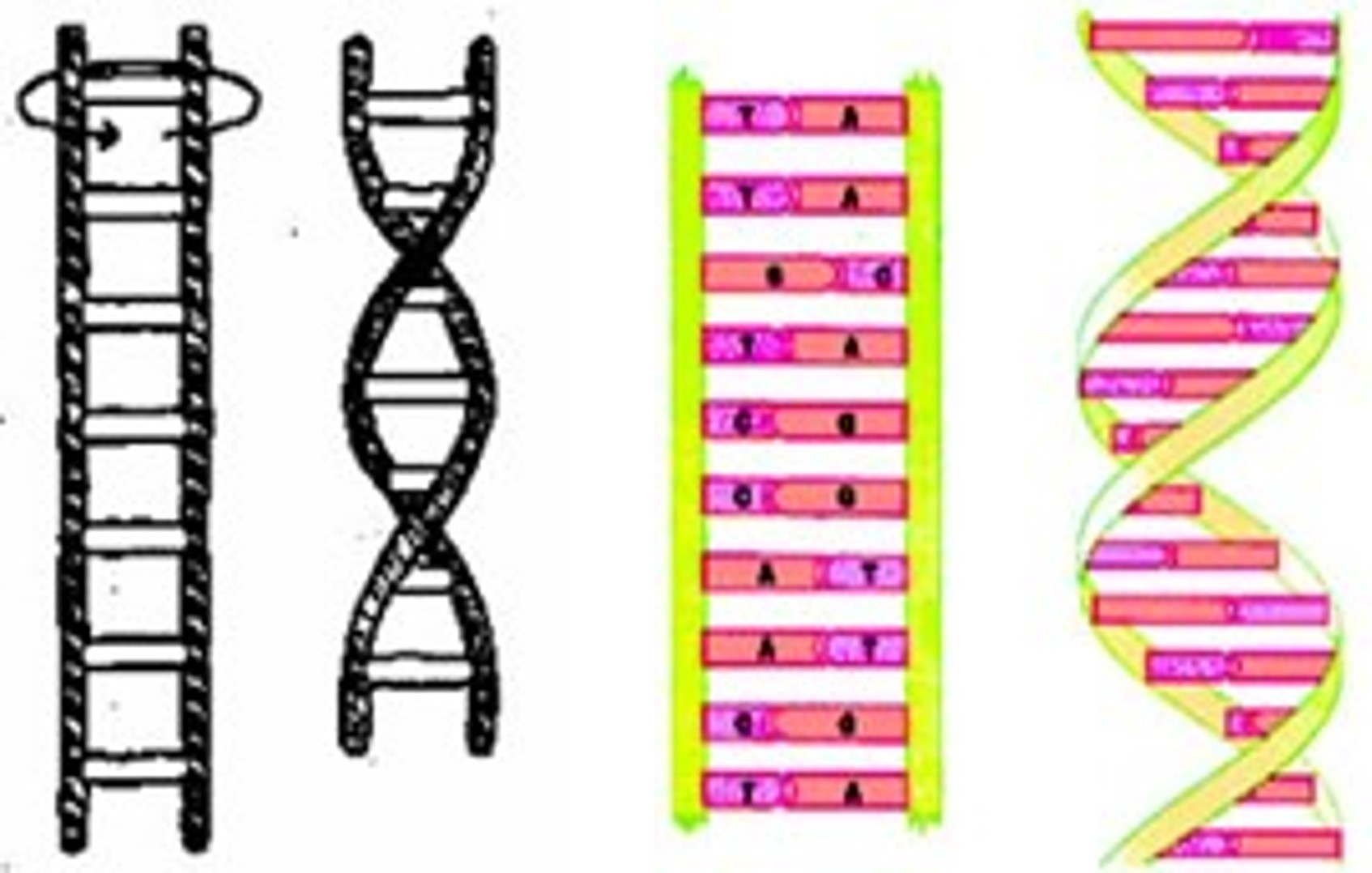
Within each cell is a separate enclosure, the nucleus. Inside this nucleus is a truly amazing substance, commonly known as DNA. Think of a ladder with its two side rails joined by the rungs. Then imagine that some giant twisted the ladder along its length, until the side rails looked like two huge corkscrews cross-connected by the rungs. Reduce this in size to a minute fraction of a millimetre and you have, in essence, the structure of a DNA molecule. The diagrams show the idea. The simple diagram shows the twisted ladder arrangement and the more complicated one the actual structure of just a short length of DNA. A complete DNA molecule would be very much longer, having many thousands of twists in its spiral rather than the few you see here. In fact if the total DNA in just one human cell could be stretched out, it would be about 2 metres long!
The wonderful thing about DNA is that along its length it contains the instructions for making all the different types of enzymes the cell needs. As the enzymes are responsible for making the chemical reactions in the cell work, you can see that DNA therefore controls the whole cell. The information about the correct sequence of amino acids in each enzyme is contained in coded form on the ‘rungs’ of the DNA ladder. There are only four different kinds of ‘rungs’, each composed of chemicals paired together (T, A, G, C in the diagram) and it needs three ‘rungs’ to code for one amino acid.
If we call the four types of rungs A B C D, then ABC might be the code for amino acid 1, BCD for amino acid 2, BCB for amino acid 3, DBA for amino acid 4 and so on. Continuing until all the 20 amino acids are coded, using only four ‘rungs’. So, in our example above, if the sequence of ‘rungs’ on the DNA molecule were BCDBCBABCDBA it would mean that the sequence of amino acids would be 2,3,1,4. In this way, a ladder of 600 ‘rungs’ could code for an enzyme of 200 amino acids in its chain. If the code sequence on the DNA was correct, then every enzyme produced from that section of its length would have its amino acids in the right order too and would therefore be able to do its job.
This only explains the principle of the code’s operation. In practice, the transfer of the coded information to the site of enzyme production is very complicated and involves other very special substances. It is estimated that to make one protein molecule, about another hundred different proteins are required as enzymes to effect the production. 4
The total amount of information along that microscopic chain of DNA is mind-boggling. In a simple cell, like a bacterium, there are several million coded symbols and in those of man there are between two and four billion. The total DNA code in a cell is styled the genome; and it is a measure of scientific progress that in recent years the whole of the human genome has been elucidated.
Reference
4 M Denton: Evolution: A theory in Crisis, page 265 (Adler and Adler 1986).
CELL DIVISION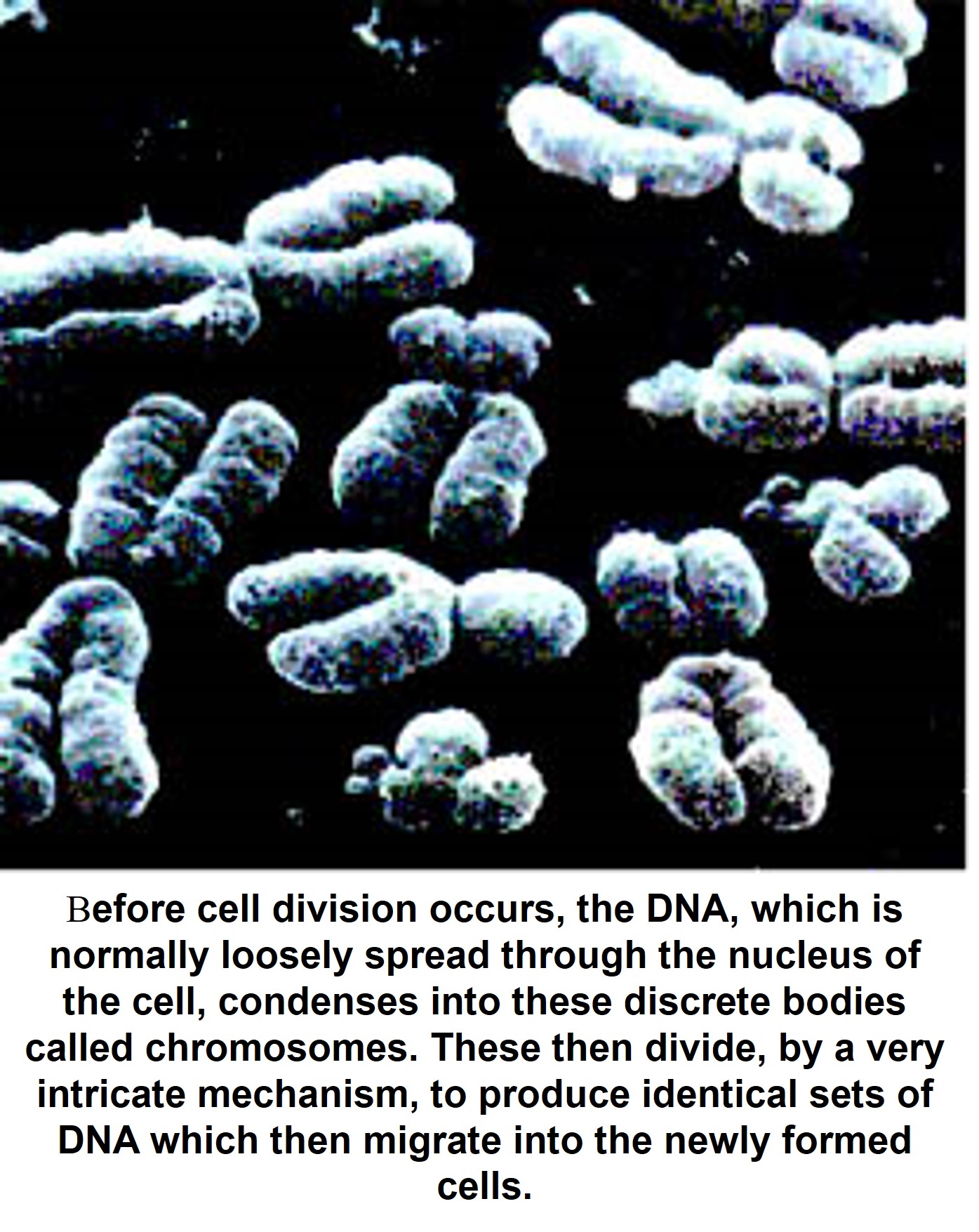
One of the definitions of living material is that it can reproduce itself. This must obviously occur first at the cellular level. For one cell to become two, the DNA must first be accurately duplicated, so that each new cell can contain the vital instructions coded on that molecule. This replication of DNA is achieved by enzymes made by the DNA itself. If you think about this you will realise that DNA and its enzymes are interdependent. The DNA makes an enzyme that in turn makes the DNA. So both must have originally appeared at the same time. Neither can function on its own. Evolutionists admit that this is a thorny problem. One of them wrote: ‘We are grappling here with a classic ‘chicken and egg’ situation. Nucleic acids [DNA] are required to make proteins, whereas proteins are needed to make nucleic acids…so how could useful proteins have first arisen and then evolved without the nucleic acids needed to encode them? How could nucleic acids be faithfully copied and evolve without the catalytic assistance of proteins?’ 5
DESIGN OR CHANCE?
Do you think that this complex yet accurate method of protein production could have occurred by chance? Could such a detailed code, with its millions of symbols, have been produced by accident? No scientist, despite confident assertions in the media and in school textbooks, has yet proposed a possible way that this detailed system could occur by chance. As one of them freely writes: ‘In their more public pronouncements, researchers interested in the origin of life sometimes behave like the creationist opponents they so despise – glossing over the great mysteries that remain unsolved and pretending they have firm answers that they have not really got.’ 6
But why do some scientists despise those who believe in creation? Surely experience teaches that complexity, such as in a cell, must have been the product of an intelligent mind. The most rational view is that God designed the ‘Code of Life’. By giving a slightly different code to the different sorts of living organisms, He brought into being all the varied forms of life, such as trees, flowers, animals, insects and mankind, as the Bible says:
‘…with thee is the fountain of life’ [Psalm 36.9].
‘…he giveth to all life, and breath, and all things’ [Acts 17.25].
But of course life on earth is not just simple cells. They are organised into groups to form organs and bodies that can see, feel, manipulate things and in the case of human beings, have the ability to reason and communicate. In all this there is the evidence of design, not accidental development.
References
5 Andrew Scott: New Scientist, 2nd May 1985, page 31.
6 Andrew Scott: New Scientist 2nd May 1985, page 33.
DESIGN DEMANDS A DESIGNER
Wherever we look then, at the Universe or inside the cell, we see that things have turned out the way they are because of a series of apparently improbable events. Each event was very unlikely to have occurred by chance. The Universe expanded at just the right rate. The Earth provided just the right environment. Then life with all its amazing complexity appeared on Earth. An accidental sequence of such events strains the bounds of credibility. Reason demands that such careful and intricate design implies the existence of a designer and a controller – a being greater than the Universe. The God of the Bible is described in just these terms:
‘Praise ye the LORD…Praise ye him, sun and moon: praise him, all ye stars of light. Praise him, ye heaven of heavens…Let them praise the name of the LORD: for he commanded, and they were created’ [Psalm 148.1-5].
‘…thou hast made the heaven and the earth by thy great power and stretched out arm, and there is nothing too hard for thee’ [Jeremiah 32.17].
THE BIBLE IS UNIQUE
In this section we have presented the current views about the origin of the Universe and the nature of life that is found in one part of it. Some ideas on the formation of the Universe are only theories, suggesting what might have happened at the beginning. It may be that tomorrow some new discovery will alter the ideas. However, with the proviso that all human knowledge is inevitably imperfect, the harmony of modern scientific discoveries with the Bible is remarkable. This is all the more so when we consider the antiquity of the book – in parts three thousand five hundred years old. If the Bible were merely the product of its age, it would have described the Creation in the self-evidently mythical way like the Babylonian and Egyptian creation stories of 3,500 years ago. In these stories all things were said to be derived from the murdered body of one of their gods or that mankind was formed from the tears of another so-called deity.
Against the background of these obviously nonsensical accounts, the Bible’s record of creation is presented as reasonable, logical and even scientific. It needs a lot of explaining if God is not taken as the originator of the information.
A PURPOSE IN CREATION
The supreme value of belief in a Creator is that everything has been made for a reason. Science may probe the distant parts of the Universe or the innermost intricacies of the living cell but it cannot tell why they are there. If an all-wise God has created everything, it is reasonable to assume a purpose in creation. Also we can learn of that purpose in the Bible, which is the Creator’s revelation to man. We are told there that mankind, far from being the result of chance evolutionary development, was created specifically to bring pleasure and satisfaction to the Almighty. It may seem at first sight that this purpose is failing but this is only from a human standpoint.
Scripture tells us that God is using the literal world to develop a spiritual creation, composed of men and women who have developed a mind and a way of life that reflect the attributes of their Creator. This spiritual creation will at last share the nature and the understanding of the Almighty Being who has created them.
This new creation was the hope of the Apostle Paul:
‘…now we see through a glass, darkly… but then shall I know even as also I am known’ [1 Corinthians 13.12].
It was also the promise of God through His son Jesus Christ:
‘He that overcometh shall inherit all things; and I will be his God, and he shall be my son’ [Revelation 21.7].
Mankind has been created ‘in the image of God’ [Genesis 1.27] and the highest use to which we can put our God-given minds and bodies is to spend our short years in preparation for the future that God has planned – not to spend our time in pursuit of satisfaction in this life.
![]()
